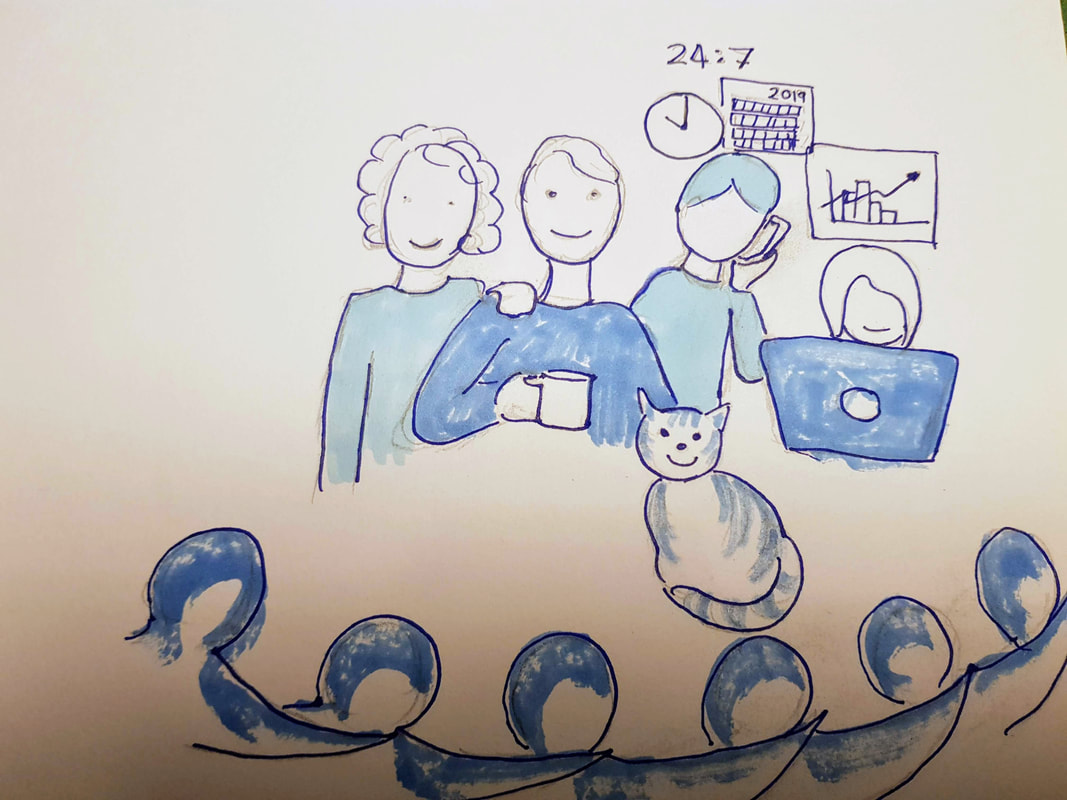|
Transitioning to a new way of operating is big. It is not only about the processes but perhaps more importantly about the culture created and developing people to work well within it. Like the world of private business, leading an organisation into this transition will require courage, creativity and authenticity. A body of work has been generated on organisations setting up to be self-organising. Laloux is currently focusing on organisations making the transition. In my work in health and care I have tried to build on Laloux’s insights. These are the foundation stones I have found to be essential in setting the scene for successful and sustainable progress. 1. Declare your intention.David Marquet talks about developing distributed leadership by announcing intent. It is important to lay good foundations to build upon and to prepare an organisation for the change. Communicating in a way that models the vision you are hoping to achieve is vital. All staff, regulators and stakeholders, leadership and the communities it serves must be aware of what is being planned. They need to hear about it and be inspired to talk about it and explore it. There will be many levels of awareness and understanding in an organisation and wider community. Many staff will view this as another management fad. People are busy and have day to day tasks to focus on and may not see this as a matter they need to pay attention to. Socialising the approach and the intent to move in this direction is key and worth taking time and effort over. It is vital that organisational leaders are leading this process, staff and the community need to know that leaders are signed up to this. Being able to articulate the vision, explain the challenges it answers and the opportunities it offers is a leadership task. Using the narrative to connect to the values and purpose of the organisations past and project and reinvent these for the future will inspire people to action. 2. Align values and approaches across the organisation and communityMaking firm connections between the ethos of care and the values that underpin this and the way the organisation operates helps people make sense of the direction being taken. In health and care increasing demands are being met successfully with work which is
Organisations moving in this direction must successfully align person centred approaches to care, customer focused approaches to corporate services, self-managing approaches to operating systems and underpin these with values and behaviours that demonstrate a commitment to wholeness and delivery of purpose. 3. A clear line of sight for values and purpose. Once people begin to understand what the vision is about two needs will surface. The first is around aligning individual values and purpose with teams and with the organisation in its new form. Many organisations have purpose and value statements that provide decoration on the walls. They are not evident in the behaviour, processes and decisions of the organisation. An organisation needs to review its purpose and values. It needs to appreciate and acknowledge the values that have brought it to this point and to ask if these are the values that can deliver it into the future it has envisioned. An approach that creates the space for people to explore this whilst at the same time giving a clear indication of the direction and vision is needed. This can be a challenge for organisations used to operating by consensus as this is not about negotiating a compromise. 4. Expect the usual reaction to proposed change. The second need, or to be more accurate this happens concurrently with the first, is people ask what does this mean for me? Do I have job, what job, how much will I earn, where, who with, doing what, how will it work? Or, will I get a service, who will work with me, where will they work, will it be as good as now, will I have to pay, and what about…? The list of questions and the detail that people will request can be surprising to leaders who more usually concern themselves with strategic matters. If someone has been able to align their personal values and purpose with the new direction set, they are more likely to want to work through these details and co-create a solution. The direction, way of working and cultural elements of the vision may seem new but the way people react to proposed change is not. Being very clear about the direction and confident about the ability of the organisation to achieve the change is important. A huge advantage of working in health and care is a workforce that is adept and eager to solve problems themselves, but this will not happen immediately. People need to time to sense make and decide what they will contribute. There will be a segment of staff and members of the community who are supportive and see the potential, but the rest will be unsure or already have decided this is a bad idea. Whether intentional or not, within the power hierarchies that exist, mangers will influence their staff and staff influence the people they care for and support. Leaders need to be working proactively to provide meaningful opportunities to explore and to direct the change process. At this stage the Leaders will need to outline and hold the space firmly for staff to take some first steps. They will need to issue invitations to people to step up and create the next stage of the journey of the organisation’s evolution. Resources are scarce, and it is possible to send a huge amount of time and energy with people who will not be influenced to support the change. Leaders need to focus attention and follow the curiosity and energy that emerges. This can feel uncomfortable for organisations that are used to a more traditional consensus approach. 5. Activate the whole leadership team. Counterintuitively perhaps, evolving into a self-organising system requires great leadership. Leaders need to understand and be confident about their role in this new type of organisation and clear about how they can support the current organisation to evolve. Their first task is to create and tell the story about why organisation is doing this and what it will be like in the future. Leaders need to be coached and supported to hold the space and issue invitations for staff to step in and take up vital roles and pieces of work. They need to plan and to rehearse their response for when things go wrong. It is important that they are there to hold a steady course and remind each other of “how we do things now around here”. Teams that will be first to try out this way of working need to know that Leaders really mean it and that they will be supported, when things go wrong. 6. Create new ways of communicating. This means moving away from hierarchical flows of information to networked conversations where staff can see work in other parts of the organisation and contact those who can help them or make offers to those they can assist. Leaders and staff need to develop confidence in storytelling and develop more transparent communication. This is not about marketing this is about authentic exchanges between colleagues. Sharing honestly their intentions and anxieties; what they have tried, what worked and what didn’t work. 7. Create new ways of learning. Developing opportunities to self-manage and self-direct learning individually and as part of teams is essential. This may mean a move away from a set menu of in-house courses to facilitating staff to set up their own research and learning programmes. Opening conversation and sharing experiences with other organisations both inside and outside the health and care system offers huge advantages. Supporting staff to develop these skills and confidence to facilitate communities of learning and establish learning networks help to create an organisation that can keep learning and improving, a vital skill to sustain self-organising teams. 8. Practice as an organisation. Being alive to opportunities to introduce key practices across the organisation. These can be very small and support key aspects of this way of working. For example, tactical meeting processes or parts of the process such as checking in, adopting circles as a way of exploring and deciding, and integrated decision making can be useful across the organisation even before it adopts the other ways of working. Adopting these at senior levels and in forums where vitally important work is conducted sends a strong message and enables leaders to share their experiences as peer learners with other staff adopting the new ways of working. 9. Wholeness This is a part of this work that many organisations struggle with. In health and care we are confident with the rational and scientific and have recently began to work more competently with the emotional and spiritual aspects of supporting and caring for people. We do not currently feel so comfortable recognising the emotional and spiritual with our staff and in our own work. Organisations in health and care can often open this door by talking about Wellbeing. This is an arena that allows us to recognise the emotional and spiritual health of staff as contributing to our ability to provide compassionate care. Widening out this agenda to include issues that we label as equality and diversity helps us to recognise other facets of a whole person. Lifestyle, culture, sexuality, caring responsibilities, disabilities and talents are all part of a person. Previously in recognising only the “professional slice” of our colleagues that we allowed at work, we failed to recognise their talent. Getting to know our colleagues better, seeing beyond their job title and banding and recognising aptitudes and talents allows us to make best use of potential and provide meaningful fulfilling work. Without this key aspect in place and staff feeling valued and respected as people, it is difficult for staff to find the motivation and confidence to step into the arena of self -organising and there is a risk that this becomes just another type of restructure. 10. Follow the invitation and the curiosity. The move to self-managing teams is often the focus of attention but this is only enabled at scale by building on a foundation of local success. Supporting teams who are energetic and curious to test and learn about how they can use these approaches will build these successes. There may be a temptation to resort back to usual programme management methodologies and impose a roll-out schedule. There is an increasing body of research that suggest that this is not effective, and this approach does not align with the values of the work being undertaken. Teams can be supported to build on their strengths in practices and processes that already speak to this way of working. Similarly, they can identify new practices that can help them with a current challenge. There may be a set of core processes and behaviours the organisation would aim all teams will adopt. Supporting teams to start where it is most relevant and important for them is more likely to lead to sustainable success. Enabling them to report progress against minimum specifications and purpose supports the change being pursued. 11. Look for minimum specifications and maximum trust. This is an opportunity to do some spring cleaning. We are great at establishing new rules and meetings to address our latest concern and not so good at getting rid of them when they no longer serve our purposes. Asking what staff and services need to do and what must they not do is a simple way to begin to outline a minimum specification and to jettison processes and procedures that support the old way of thinking and working. Reviewing the complicated data collected and co-creating KPIs that reach into the heart of what is important to everyone can provide meaningful and robust assurance. 12. Celebrate Collect the stories and tell them inside and outside the organisations. This sounds very simple but in health and care there are anxieties about sharing our pioneering work and being criticised. A sensational press headline or hostile parliamentary question can squash innovation and lead to accusations of irresponsible practice and imprudent use of scarce public resources. There will be people who find their positions and practices threatened by these new ways of working that are keen to find evidence of failure. Its vital to set the tone. Talk honestly about our experiences, the challenges being faced and the anxieties that are surfacing. Sharing the stories about the practices that are emerging and the learning and knowledge with the wider organisation is an essential task. Most importantly is enabling the staff and the people they support to talk about being able to do what is important and how they can make a difference. Describing how they have taken tough decisions together and how they are held accountable for them. 13. Support develop and coach. The ethos that underpins this approach is about learning and development on a personal, professional and organisational level. There are already schools organised and teaching using self-organising systems, but at present most of the people currently working in or being recruited into health and care will not be skilled or confident in this way of working. Building safe environments where feedback is generative, learning is generous, and coaching is the way things are done around here is essential to helping staff and citizens thrive in this new environment. 14. Be clear about assurance. Laloux cautions “a common mistake is to get rid of existing control mechanisms without putting in place what’s needed for systems to self-correct.” This is an arena that causes much stress in the health and care system. I have experienced several Boards and leadership teams who are rich in all kinds of data processed through a range of meetings but when asked still cannot answer confidently “how do you know”? There are some key pieces of data and, some information that organisations are required to collect and report for political reasons. These measures do not necessarily add anything to our ability to assure or improve. Being very clear about purpose and values and using data and reflective techniques to understand delivery of purpose is key. Rethinking the information provided and distributing it to teams in a form that enables them to understand where they are at is a new activity for most health and care organisations. Adopting an approach of “behind every stat is a story” is also helpful in encouraging data to be linked and conversations to be held that enable us to really understand what the position is and why. 15. Continuous improvement. This is properly and closely linked to assurance. In health and care there is a focus on continuously improving safety and quality and a yearly round of cost improvements imposed on every budget. Most staff I have worked with are genuinely committed to doing better for the people they support and care for. They strive to improve in difficult circumstances. Improvement is no longer about doing the same things more efficiently but about challenging ourselves to understand the value in what we do. Moving is this direction requires us to rethink our approach to improvement and focus it around achieving our purpose and creating value for the people and communities we serve. I responded to Anya De Longh this morning. https://blogs.bmj.com/bmj/2018/10/03/prescribing-personalised-social-pharmacological/
I describe myself as having an allergic reaction to the term social prescribing and this I think my answer below helps to explain why. It’s good that we are starting to recognise health as social and develop our practice accordingly. I worked with a practice recently where GPs were frustrated that what they could provide was not what their patients really needed. It was important to them and to most health care staff to know they can make a difference. Social prescribing enables them to do more of that. I had a conversation yesterday with someone who works for a CIC. They have a 30-year history of working with disengaged and hard to reach groups on community projects which make a difference to the individuals and help build the communities they live in. However, the CIC is under threat as the funding streams from local authorities, youth offending schemes and regeneration have disappeared. He had a conversation with a local GP, aware of the impact of the work the CIC does, who wanted to have this option on his prescribing list. However, a further conversation with the practice manager revealed this was not an option, they could only prescribe to funded projects and social prescribing funds have been cascaded down the health route. By trying to deliver a non-traditional approach in a traditional way we are at risk of further limiting the choice of the people we seek to support. We are viewing the issue through our own “health lens” and allocating resources according to our values and agenda. Activists are receiving the message that if they want to do something in their communities they must fund it themselves or rely totally on volunteers. If we are serious about empowering individuals to take responsibility for their own health and supporting communities to provide opportunities for this to happen then we need to give them the power AND the resources to do this. The issue with social prescribing, which is reflected in the language we use is the power and control. Social prescribing is a good start. I hope that as we change the language of this developing practice we can change the attitudes and the behaviours that underpin it too. We just need to do this quickly or the further community assets that are being starved of resources will wither and die. When we consider the current challenges and approaches in Health and Care the reasons to “Take it Teal” become self-evident. The challenges are big and complex and making what we already do more efficient will not help. Indeed, there is evidence that some of these previous initiatives have been counterproductive and have disengaged staff and left citizens dissatisfied with the service they received. The programme to develop Integrated Care Organisations is already underway. Based on subsidiarity, there is no central blueprint, local health and care systems are designing what can improve health in their own neighbourhoods and across their own systems. Moving towards self-organising systems and self-managed teams requires a similar approach. There is learning and experience that can be shared but each system and organisation will need to make it their own. It makes sense to align subsidiarity in the systems and neighbourhoods with subsidiarity in the services that support these neighbourhoods to give them the agility to meet local needs. Health care used to provide treatment for episodes of illness. Its task was to fix the problem and discharge people back to their usual lives. It now needs to deliver long-term support to growing numbers of older people and those living with long-term conditions. This means enabling self-care and self-management of long-term conditions. To be successful health staff need to focus on what’s important to the citizen they are supporting and provide person-centred care. The educational, coaching and developmental techniques used to support citizens to step up and take control of their health and wellbeing are the same approaches that can support staff to take control and manage their own work. Working in this way restores the autonomy removed from workers in recent times and gives them back the ability to make a difference. The improved job satisfaction and customer satisfaction which results improves recruitment and retention rates, another key issue in today’s health sector. Our current approach to health, treating our illnesses and conditions, is not sustainable. We need to work upstream, promote wellness and prevent illness. Health is social, there is a physical element to this and a great contribution that medicine can make but we need a broader appreciation of what makes us healthy and feel happy and well. We recognise that our neighbourhoods and communities play a vital role and we are developing towards being able to value them and work in ways that respect this. In organisations we know that the culture in which we work has a dramatic impact on our performance and our staff wellbeing. Creating organisations and working in ways that maximise the health and wellbeing of our staff and respect and value our communities is a moral imperative. These new ways of working enable us to do this. In health care we are now more accepting of the emotional and spiritual aspects of health, we can prove the benefits of compassion and more holistic approaches to care with patient outcome data. It therefore makes sense that we should view wellbeing and wholeness for our staff in the same way. Creating workplaces where we welcome the whole person allows us to address issues of equality and diversity in context, not as a separate issue. It allows us to value and harness all the talents and passions of our staff to their work, not just the slither of person that might be reflected in a job description. It enables us to model health promoting approaches for other organisations in our systems and treat our staff in the way we hope they will treat the citizens they support and care for. Safety, quality and continuous improvement have long been a focus of healthcare with varied success. Self-organising approaches release the energy of staff and teams committed to doing their best for the people they care for. These staff are best placed to spot the dangers, experience the frustrations and identify the improvements that will deliver the biggest advantages for the people they support. Continuous improvement is an integral part of the self-management team approach. Adopting self-organising approaches in teams and supporting them to pursue their own improvement agenda rigorously will produce the safety and quality we aspire to. Adopting this approach allows organisations to align their operating process with their approach to delivering to their purpose and providing care and support to improve the health of their communities. Whether we look at NHS values, the 6 Cs or the 7 principles of care, this way of working enables us to live them. If we are serious about preserving these values and principles and creating a way for them to not only to survive but thrive into the next 70 years, this is the way forward. |
AuthorJane Pightling has experience across the public, private and charitable sector. Through her work in the NHS Leadership Academy and her consultancy Evolutionary Connections she developed complex systems leadership capacity, providing training, coaching programmes and establishing networks and communities of practice to sustain learning. She maintains her social work registration and her commitment to person centred and community focused approaches. Jane has a deep interest in the potential offered by new ways of working, designing and building organisations and communities that can best deliver this kind of service. She works with organisations and leaders to develop approaches that design in autonomy, wholeness and purpose. Archives
October 2021
Categories
All
|





 RSS Feed
RSS Feed